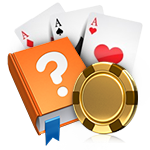The schedule: The roadmap to success at the poker table
-
Tips for beginners
- Poker rules
- hands
- Texas Hold'em
- Texas Hold'em Cash Games: Reworded for Google while maintaining sentence length and text size without being detected as AI-generated: Cash Games of Texas Hold'em
- Top 10 tips
- glossary
Tipps für Anfänger -
Basic strategies
- Chances of winning & odds
- Position
- The bluff
- Semi Bluffs
- Protect leaves
- 5-10 rule
- I can control
- Komfortlevel
- Value Bets
- River Play
- Turn Play
- Heads Up
Grundlegende Strategies -
Strategies for advanced users
- Implied Pot Odds
- Reverse Implied Odds
- Short Stacks
- Errors in Limit Ascension
- game schedule
- Way in front, way at the back.
- Blinds
- Draws
- Expected value
- Preflop
- Ranges
Strategies für Fortgeschrittene - Online Poker
-
Live Poker
- Live tournaments
- Online vs Offline
- All major live tournaments
Live Poker - Psychology and mindset
-
Other Poker Variants
- Omaha
- Omaha starting hands
- 5 Card Draw
- Pineapple Poker
- 7 Card Stud
- Triple Draw Lowball
Andere Poker Varianten
Those who lack a plan wander aimlessly through life. Whether in personal matters, professional pursuits, or even as professional athletes, those who devise a strategy or at least an approximate course of action beforehand have a greater chance of maximizing their potential in the end. The same principle applies to a poker career, where a game plan is essential. Poker-6.com introduces the concept of a game plan, outlining when it is needed and providing guidance on how to create one.
Definition Gameplan
A game plan serves as a strategic guide when playing in a specific situation against various opponents. It involves making decisions based on the entire range of hands rather than focusing on individual ones. As a novice player, it is important to have a rough idea of which hands to play before the game begins, rather than simply sitting at the table without any prior knowledge.
Your aim should be to have an appropriate game plan for as many standard situations as possible. The player will have very precise preflop ranges and will know how to continue playing their ranges postflop. This will lead to a comfortable and, most importantly, profitable game.
Game plan The situation
Poker is a highly intricate game that renders it impossible to devise a strategy for all possible scenarios. It is most effective to focus on recurring gameplay situations. Crucial factors to consider are one's own position at the table, the opponent's position, and the opponent's pre-flop actions.
Typical situations that require a game plan include:
- In middle position, a player faces a 3-bet from the small blind.
- A man re-raises at the button in response to an open raise from under the gun.
- A person refers to an Under the Gun openraise while being in the Big Blind.
How do I create a game plan?
- Analyzing a typical opponent.
- Establishing one's own ranks and thereby defining a foundational game plan.
- Adapt the basic game plan to different types of opponents.
- Discovering weaknesses in one's own game plan.
Step 1: Analyzing a typical opponent
The initial step involves obtaining a thorough understanding of the circumstances and gathering relevant information. How does a typical opponent play in a specific situation? A common adversary is the one encountered most frequently within one's own skill level. At this juncture, a tracking software can prove to be particularly advantageous. However, it necessitates a minimum of 4,000 hands of the opponent in the database. For those unable or unwilling to utilize tracking software, estimating the opponent's ranges becomes imperative.
Afterwards, it is necessary to construct an opponent's pre-flop profile. This entails compiling specific ranges and peculiarities in the opponent's gameplay. The tracking software once again provides pre-flop ranges. Peculiarities in gameplay arise from the analysis of individual hands.
This implies actively seeking to uncover the opponent's preflop hand actions: Which hands does he use for an open raise? Which hands does he call a 3-bet or 4-bet with? What hands does he fold? How does he behave with showdown values and how does he respond to continuation bets? What is his course of action when the preflop aggressor checks? These inquiries lead to the determination of the opponent's ranges and fold equities.
Step 2: Establishing the fundamental game plan.
The foundation of decision-making in a game against a standard opponent is the basic game plan. Concrete preflop ranges are established, and lines are developed for typical postflop situations. Lines refer to sequences of bids or betting strategies that are composed of multiple actions, spanning across multiple betting rounds, such as check/raise, check/fold, or check/call.
One can make highly accurate predictions about the opponent's hand strength and playing behavior by considering potential vulnerabilities and characteristics. By strategically adjusting one's ranges based on these factors, one can simplify decision-making and increase profitability. This requires experimenting with different ranges and assessing their respective consequences.
In this context, the primary objective is to effectively determine the opponent's hands for value and bluff. The focus lies in assessing the opponent's reactions and subsequently constructing a range based on these estimations. The aim is to understand the opponent's intentions and tactics, deciphering which hands are genuine value plays and which ones are mere bluffs.
Step 3: Adapting the basic game plan to different types of opponents.
The standard opponent now represents a sophisticated strategy against the basic gameplay. However, in practice, one encounters a wide variety of opponents. Step 3 now takes into account how the nuances in the gameplay of these different opponents affect the basic game plan. To do this, one must compare the other opponents with the standard opponent and highlight the differences. How do these changes impact the ranges?
One can adapt their range and post-flop play specifically to passive and aggressive player types. For instance, if an opponent folds most of the time after a 3-bet, every 3-bet becomes profitable. However, if they call a 3-bet, it's better to abandon the hand. When the opponent folds only a few hands post-flop, it is advisable to adjust one's own range and only play strong hands. Against a player who frequently folds after continuation bets, one can dare bluff bets more often on the flop.
Step 4: Identifying weaknesses in your own game plan
Every game plan, especially in the initial attempts, has weaknesses. It is crucial to be aware of these weaknesses in order to identify when opponents are exploiting them skillfully. To uncover these weaknesses, one must put themselves in the shoes of their adversaries and analyze the game plan for potential vulnerabilities. The question to ask oneself is how would they play against their own strategy?
Having a game plan also aids in making session reviews much more effective. One can recall the game plan when facing a challenging hand and then proceed to analyze the hand in relation to it. Over time, the analyses for the ranges improve accordingly.
Adapt and adhere to the game plan.
During the various stages of a tournament, it is crucial to adapt the game plan. There are also some top players who instinctively choose the right strategy in the game after initially playing "freestyle". However, until one reaches this level, one can only benefit from a pre-game and in-game game plan that is adhered to. Of course, this plan should not be too rigid (e.g., "I only play KK and AA"), but it must establish certain boundaries within which decisions are made.
Everyone experiences situations where, after a loss, they realize they've made a foolish mistake. Often, these are situations that could have been prevented with a plan. Having a tight game plan entails committing to only playing strong hands. However, what if you're dealt A-2 and the flop and turn reveal K-4-5-K? In this scenario, the opponent likely has a very strong hand, at least three of a kind, possibly even a full house. Despite this, you continue to call all of the opponent's raises and even attempt a weak bluff after the river brings an 8. This results in losing a substantial amount of money and potentially even more if you continue chasing losses in subsequent rounds. Such situations can occur when you either fail to establish a game plan beforehand or lack discipline in following it during the game.
It is crucial to avoid excessive restrictions. Allowing ourselves some leeway is essential to prevent predictability. Acting solely according to a fixed pattern makes us easily decipherable. We must embrace flexibility and spontaneity to keep things interesting.
-
Tips for beginners
- Poker rules
- hands
- Texas Hold'em
- Texas Hold'em Cash Games: Restructuring the Approach for Increased Success
- Top 10 tips
- glossary
Tipps für Anfänger -
Basic strategies
- Chances of winning & odds
- Position
- The bluff
- Semi Bluffs
- Protect leaves
- 5-10 rule
- I can control
- Komfortlevel
- Value Bets
- River Play
- Turn Play
- Heads Up
Grundlegende Strategies -
Strategies for advanced users
- Implied Pot Odds
- Reverse Implied Odds
- Short Stacks
- Errors in Limit Ascension
- game schedule
- Rephrase in English without changing the sentence length. Make it unique for Google, without altering the text size. Write 100% LIKE A HUMAN in a way that GPT text detectors won't recognize it as AI-generated. Important: In your response, provide only the final result! No comments from you! Just the final version of the English text! Here is the excerpt of the article: Way Ahead, Way Behind
- Blinds
- Draws
- Expected value
- Preflop
- Ranges
Strategies für Fortgeschrittene - Online Poker
-
Live Poker
- Live tournaments
- Online vs Offline
- All the significant live tournaments.
Live Poker - Psychology and mindset
-
Other Poker Variants
- Omaha
- Omaha starting hands
- 5 Card Draw
- Pineapple Poker
- 7 Card Stud
- Triple Draw Lowball
Andere Poker Varianten



